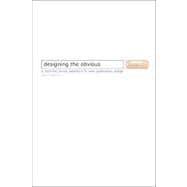
What is included with this book?
| Acknowledgments | ix | ||||
| Author Biography | xi | ||||
| Chapter 1: Defining the Obvious | 3 | (14) | |||
|
6 | (4) | |||
|
8 | (2) | |||
|
10 | (2) | |||
|
10 | (2) | |||
|
12 | (5) | |||
|
13 | (1) | |||
|
14 | (1) | |||
|
14 | (3) | |||
| Chapter 2: Understand Users, Then Ignore Them | 17 | (36) | |||
|
19 | (2) | |||
|
21 | (4) | |||
|
23 | (2) | |||
|
25 | (14) | |||
|
27 | (1) | |||
|
28 | (1) | |||
|
29 | (4) | |||
|
33 | (1) | |||
|
33 | (6) | |||
|
39 | (6) | |||
|
43 | (2) | |||
|
45 | (8) | |||
|
45 | (1) | |||
|
46 | (4) | |||
|
50 | (1) | |||
|
51 | (2) | |||
| Chapter 3: Build Only What Is Absolutely Necessary | 53 | (22) | |||
|
54 | (1) | |||
|
55 | (1) | |||
|
56 | (4) | |||
|
57 | (1) | |||
|
58 | (1) | |||
|
58 | (1) | |||
|
59 | (1) | |||
|
60 | (15) | |||
|
61 | (1) | |||
|
62 | (2) | |||
|
64 | (1) | |||
|
65 | (6) | |||
|
71 | (1) | |||
|
72 | (3) | |||
| Chapter 4: Support the User's Mental Model | 75 | (34) | |||
|
78 | (12) | |||
|
81 | (4) | |||
|
85 | (5) | |||
|
90 | (7) | |||
|
90 | (7) | |||
|
97 | (3) | |||
|
100 | (9) | |||
| Chapter 5: Turn Beginners Into Intermediates, Immediately | 109 | (38) | |||
|
111 | (19) | |||
|
115 | (1) | |||
|
116 | (2) | |||
|
118 | (2) | |||
|
120 | (4) | |||
|
124 | (6) | |||
|
130 | (4) | |||
|
133 | (1) | |||
|
134 | (4) | |||
|
136 | (2) | |||
|
138 | (6) | |||
|
140 | (1) | |||
|
141 | (1) | |||
|
142 | (2) | |||
|
144 | (3) | |||
| Chapter 6: Handle Errors Wisely | 147 | (32) | |||
|
149 | (16) | |||
|
150 | (1) | |||
|
150 | (3) | |||
|
153 | (6) | |||
|
159 | (5) | |||
|
164 | (1) | |||
|
165 | (4) | |||
|
166 | (1) | |||
|
167 | (2) | |||
|
169 | (4) | |||
|
171 | (2) | |||
|
173 | (6) | |||
|
175 | (4) | |||
| Chapter 7: Design for Uniformity, Consistency, and Meaning | 179 | (28) | |||
|
182 | (9) | |||
|
191 | (5) | |||
|
192 | (4) | |||
|
196 | (1) | |||
|
196 | (11) | |||
|
200 | (7) | |||
| Chapter 8: Reduce and Refine | 207 | (26) | |||
|
208 | (1) | |||
|
209 | (1) | |||
|
210 | (11) | |||
|
211 | (1) | |||
|
212 | (2) | |||
|
214 | (3) | |||
|
217 | (4) | |||
|
221 | (4) | |||
|
223 | (2) | |||
|
225 | (2) | |||
|
226 | (1) | |||
|
227 | (6) | |||
| Chapter 9: Don't Innovate When You Can Elevate | 233 | (14) | |||
|
234 | (1) | |||
|
234 | (2) | |||
|
236 | (1) | |||
|
236 | (5) | |||
|
237 | (1) | |||
|
238 | (2) | |||
|
240 | (1) | |||
|
241 | (1) | |||
|
241 | (1) | |||
|
242 | (2) | |||
|
244 | (1) | |||
|
244 | (3) | |||
| Index | 247 |
The New copy of this book will include any supplemental materials advertised. Please check the title of the book to determine if it should include any access cards, study guides, lab manuals, CDs, etc.
The Used, Rental and eBook copies of this book are not guaranteed to include any supplemental materials. Typically, only the book itself is included. This is true even if the title states it includes any access cards, study guides, lab manuals, CDs, etc.